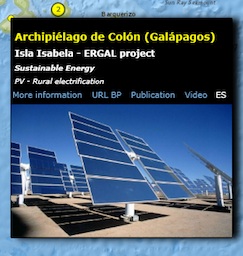ERGAL Project, Renewable Energies for Galapagos islands.
 Protected as a national park and recognised as a Biosphere Reserve and World Heritage site by UNESCO, the Galapagos Islands are an ecosystem with worldwide significance. Each year, some 160,000 tourists visit the islands. A major threat to the archipelago comes from the unreliable, CO2-intensive power supply, which is derived almost exclusively from thermal energy. Most of this supply comes from old diesel-driven generators that pollute the environment and frequently break down. Not only does this kind of power generation contribute to excessive CO2 emissions, the transportation of fossil fuels and the associated risk of tanker accidents are a danger to world heritage.
Protected as a national park and recognised as a Biosphere Reserve and World Heritage site by UNESCO, the Galapagos Islands are an ecosystem with worldwide significance. Each year, some 160,000 tourists visit the islands. A major threat to the archipelago comes from the unreliable, CO2-intensive power supply, which is derived almost exclusively from thermal energy. Most of this supply comes from old diesel-driven generators that pollute the environment and frequently break down. Not only does this kind of power generation contribute to excessive CO2 emissions, the transportation of fossil fuels and the associated risk of tanker accidents are a danger to world heritage.
The project aims to support sustainable development in Ecuador, reducing CO2 emissions related to electricity generation through the introduction of photovoltaics, wind and biofuels (pure vegetable oil pinion) as substitutes for fossil fuel (mainly diesel) used in electricity generation in the Galapagos archipelago. Conceived as the ‘Umbrella Project’, ERGAL is intended to optimize use of resources destined to the re-electrification of Galapagos with technologies based on renewable energy resources.
One of the first initiatives in this field was the “Integration Project for the Sustainability Infrastructure of Floreana Island”, conceived in 2000 by the Directorate of the Galapagos National Park through the Spanish cooperation program Araucaria, which saw the construction of an infrastructure for electrification of the island based on solar energy.
In 2007, wind power came to Galapagos and Ecuador, with the first mills in the country installed on the island of San Cristobal. The San Cristobal Wind Project has as its main objective to replace, as far as technologically and economically possible, the existing power generation based on combustion of diesel, with a clean source of energy based on wind turbines in order to make optimal use of this renewable source and avoid environmental hazards caused by the current system.
In 2012, The Korea International Cooperation Agency (KOICA) builds a 1.5MW solar power complex in the Galapagos Islands. The design process has been wrapped up recently and the bidding procedure starts late this month. The capacity is equivalent to 700 households’ annual power consumption assuming that each of them consumes 300kW on monthly average.
The Ecuadorian Government has now set itself the goal of fully converting the energy supply on the Galapagos Islands to renewable energies by 2020. To this end, it has introduced a national policy of ‘Zero fossil fuels on Galapagos’.
The government of Ecuador plans to take the renewable energy lessons it learns on the Galapagos and roll them out to the rest of the country. Lines of action are to be piloted on the Galapagos Islands, under the global spotlight due to their UNESCO World Heritage and biosphere reserve status. Thus this project will act directly as an example, not only to the other islands in the Archipelago, but also to Ecuador as a whole.
ERGAL Project
Related links:
![]() Displacing Diesel: Powered Generation by Renewable Energy in the Galapagos Islands | Global Sustainable Electricity Partnership
Displacing Diesel: Powered Generation by Renewable Energy in the Galapagos Islands | Global Sustainable Electricity Partnership
Climate protection through the use of renewable energies on the Galapagos Islands, with special focus on power generation using jatropha oil | GIZ project
RE in Galapagos | Parque Nacional Galapagos
Galapagos Wind | Eolica San Cristobal SA – UNDP















